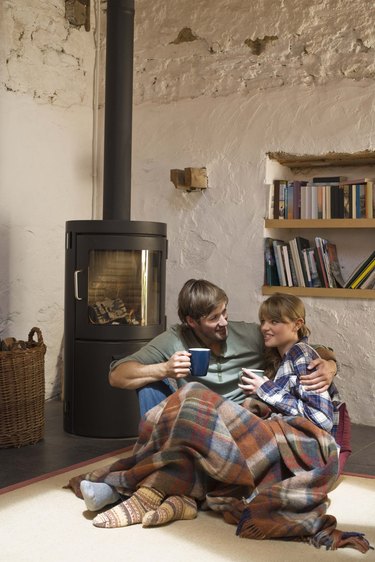
When you use less than the recommended clearance space for a wood stove, you can create the perfect conditions for your home to catch on fire. If doesn't take long for a wood stove to reach a temperature of 500 degrees Fahrenheit, and at that point the wall behind the stove can begin to burn. This is why using the right clearance is extremely important. Manufacturers, the National Fire Protection Agency and Underwriters Laboratory work together to determine clearances so that using your wood stove will be a safe and enjoyable experience.
Listed and Unlisted Stoves
Video of the Day
A "listed" stove is one that has undergone tests by an independent laboratory to determine the recommended wall clearance. Most new stoves are listed, and some may even have clearances as low as six inches. These stoves are allowed a reduced clearance because they are manufactured with built-in heat shields within the body of the stove. Stoves that are listed often state so on the back ID plate for the stove and in the owner's manual. If you have a stove that's 10 years old or more, it is safe to assume that it is probably unlisted. However, you can check your owner's manual and the back plate on the stove to be sure. Follow the National Fire Protection Agency clearance recommendations if your stove is unlisted.
Video of the Day
NFPA Standard Clearance
The National Fire Protection Association sets standards for wall clearances that are adhered to by stove manufacturers and most local building code agencies. The standard clearance recommended by the National Fire Protection Agency is 36 inches. This means that the back of the stove should be 36 inches away from any combustible material, such as woodwork, unprotected walls, furniture and even firewood. The 36-inch recommendation applies to any type of heat-resistant material, such as one-quarter-inch millboard that is nailed directly to the wall. To measure the clearance distance, simply take a tape measure and run it in a straight line from the back body of the stove to the wall, even if the stove is placed in a corner.
NFPA Reduced Clearance for Protected Walls
If the wall is protected with some form of insulation or heat-resistant material, the clearance can be less than 36 inches. For example, the National Fire Protection Agency clearance recommendation reduces to 18 inches if the millboard is attached so that there is one inch of air space between the back of the millboard and the wall. The same 18-inch recommendation applies when you attach a piece of 28-gauge sheet metal to the millboard. However, if you allow one inch of air space between the sheet metal and attach it to either one-quarter- or one-eighth-inch millboard, the recommended clearance is reduced to 12 inches.
Stove Pipe Clearance
The standard clearance for a stovepipe is 18 inches to an unprotected ceiling. Follow the 18-inch guideline if your stove should adhere to the 36-inch recommendation for wall clearance. You can reduce the clearance for the stovepipe to 12 inches if you are following the 18-inch wall clearance recommendation; and you can reduce it down to 9 inches if you are using the 12-inch wall clearance recommendation.
- Hearth: Wood Stove Clearances
- National Agricultural Safety Database; Wood Stove Installation and Operation; Ronald C. Jester; October 1991
- Hearth: How to Ensure Safe Stove Clearances to Combustibles; Ken Rajesky
- Renovators.com: Wood Stoves
- National Fire Protection Agency: Overview
- My Great Home: Installing a Fireplace or Wood Stove